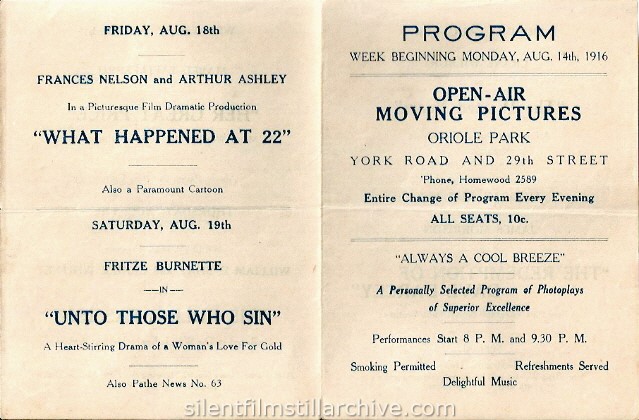![]()

Oriole (Baseball) Park (and outdoor theatre), Baltimore, Maryland - August 16, 1916

PROGRAM
WEEK BEGINNING MONDAY, AUG. 14th, 1916
OPEN-AIR MOVING PICTURES
ORIOLE PARK
YORK ROAD AND 29th STREET
'Phone, Homewood 2589
Entire Change of Program Every Evening
ALL SEATS, 10c
"ALWAYS A COOL BREEZE"
A Personally Selected Program of Photoplays of Superior Excellence
Performances Start 8 P.M. and 9.30 P.M.
Smoking Permitted
Refreshments Served
Delightful Music
FRIDAY, AUG. 18th
FRANCES NELSON and ARTHUR ASHLEY
In a Picturesque Film Dramatic Production
"WHAT HAPPENED AT 22"
Also a Paramount Cartoon
SATURDAY, AUG. 19th
FRITZE BURNETTE
--IN--
"UNTO THOSE WHO SIN"
A Heart-Stirring Drama of a Woman's Love for Gold
Also Pathe News No. 63

MONDAY, AUG. 14th
CRANE WILBUR
-IN-
"The Wasted Years"
A Five Part Mutual Masterpiece
Also a Good Comedy
TUESDAY, AUG. 15th
JAMES MORRISON
-IN-
"THE REDEMPTION OF DAVE DARCEY"
A Five Part Vitagraph Blue Ribbon Feature
SPECIAL
Camp Harrington, Laurel, Md.
President Wilson will be shown inspecting the 4th and 5th Regiments
WEDNESDAY, AUG 16th
MABEL TALAIFERRO
-IN-
"HER GREAT PRICE"
A Metro Wonder Play in Five Gripping Parts
Also a Paramount Bray Cartoon
THURSDAY, AUG. 17th
WILLIAM FOX Presents
WILLIAM E. SHAY and CLAIRE WHITNEY
-IN-
"THE RULING PASSION"
Produced in The West Indies by Herbert Brenon
Also Pathe News No. 62 Showing the Fifty Million Dollar Explosion in New York
NOTE: This baseball stadium was the home of the Baltimore Oriloes from 1916 through 1944, when the wooden structure was destroyed in a fire. This team was in the minor-league International League, and relocated to Richmond, Virginia when the St. Louis Browns moved to Baltimore in 1954 to become the Baltimore Orioles.
There were no night games, so the stadium could easily screen films
in the evenings. It was likely only used for films during the summer
months, as Baltimore gets quite cold in the winter. There were no
air-conditioned theaters in 1916-1917, so an open-air theater was
probably quite comfortable in the summer. -- Bruce Calvert
Last Modified May 4, 2016














